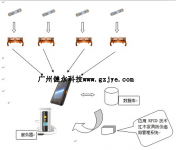
A certain mahogany furniture RFID anti-counterfeiting and anti-crossing system
[ad_1]
According to statistics from the China Consumers Association in the past two years, the market pass rate of mahogany furniture is only 40%. As consumers of mahogany furniture, very few people have the professional knowledge to identify mahogany materials, and it is difficult to figure out the authenticity of the materials purchased. In the event of a consumer dispute, it is often difficult for consumers to obtain legal recognition only by relying on furniture material inspection reports issued by some relevant agencies in the process of protecting their rights. The black-hearted businessmen are taking advantage of this, using shoddy products and false ones. From a nationwide perspective, such phenomena are more serious, and the media have frequently exposed them, and even some “well-known” companies have also fallen into it. This phenomenon has seriously distorted the mahogany furniture market, causing losses to consumers, and also affecting credible companies. Therefore, the market urgently needs to strengthen governance and introduce relevant measures. In response to this situation, we have launched the “RFID-based anti-counterfeiting and anti-crossing system for mahogany furniture” in a timely manner, so that mahogany furniture has safe and effective anti-counterfeiting and tracking protection measures from circulation to use and maintenance.
1. The needs of a mahogany furniture company
1. Anti-counterfeiting of mahogany furniture. Through the uniqueness of RFID electronic tags, each piece of mahogany furniture is given a unique ID, and then a database is established to associate the material, quality inspection report number, brand name, product name and other information of each piece of mahogany furniture to the corresponding ID number , Stored in the database. Manufacturers, distributors, and consumers can collect the RFID electronic tag ID number of mahogany furniture in the official platform designated by the manufacturer, and then they can directly query the authenticity of mahogany furniture.
2. Mahogany furniture is anti-skewed goods. Using the uniqueness of the RFID electronic tag, when the mahogany furniture is out of the warehouse, enter the dealer corresponding to the ID number of each mahogany furniture, so that there is clear evidence to check whether the goods are crossed in the later stage.
3. Traceability function. Simply record product information and corresponding ID numbers, as well as outbound information, which is convenient for later dealers and consumers to inquire about authenticity, and manufacturers to inquire whether or not the goods are crossed.
2. System overview
This solution uses a management system composed of radio frequency electronic tags and JY-H7800 high frequency industrial flat panel plus management software. Before the mahogany furniture is painted and installed, the electronic tags are placed in the furniture, and then the codes are read and entered into the database for archival backup. When the furniture is installed and shipped out, the system will be used for all-round management, including storage, storage, and inquiries.
Take an example to illustrate part of the realization of the function, the furniture is stored in the warehouse, after reading the code with the handheld industrial tablet, enter the product information of each furniture (quality inspection report number, brand name, product name, etc.), so that after the information is backed up, future managers and distributors , Consumers use the tablet or mobile phone NFC function to read the label in the furniture to get the furniture quality inspection report number, material, brand name, product name, dealer and other related information. The management purpose of anti-counterfeiting and anti-crossing goods tracking is achieved.
System technical characteristics:
First of all, product anti-counterfeiting. The anti-counterfeiting electronic label chip adopts digital anti-counterfeiting measures for the anti-counterfeiting of machine-readable information. Using digital technology to encrypt, digitize product information such as quality inspection report number, brand name, product name, manufacturer, production date, etc., and store it in the RFID electronic tag chip. The electronic label will be attached to the product to ensure normal use in various environments. Use high-frequency industrial-grade tablet or mobile phone NFC function to read ID, complete electronic tag anti-counterfeiting authentication and machine-readable information security confirmation, which effectively plays a role in product anti-counterfeiting.
Secondly, in the certification of product circulation and use, whether there is a phenomenon of collocation of goods. Customers or authorized suppliers can quickly identify the authenticity of the product, dealer information, and warranty period by simply shaking the product through the NFC function of a high-frequency industrial tablet or mobile phone. It can effectively maintain market order, improve the efficiency of product inspection and identification, eliminate unnecessary disputes, protect the interests of authorized suppliers, and improve customer service levels.
Furthermore, the visualization of product warranty, maintenance, and tracking is realized. Products have a certain service life, short or long, and after many different products form a complete system, users usually cannot know the start and end time of each product, which causes the maintenance and repair of the system products to become one. A passive job. Only when the product fails can it be known that the product needs to be replaced, resulting in loss of time and efficiency. And if the products are managed using RFID, the visualization of each product’s warranty, maintenance, and tracking will be realized. During daily inspections, the customer’s maintenance personnel can quickly identify the product warranty period, when it expires, and planned maintenance time by simply shaking the product through the NFC function of the mobile phone, and unify multiple pieces of scattered information to An RFID saves staff time and reduces the cumbersomeness of product maintenance and management.
as the picture shows:

Three, software system introduction
The RFID anti-counterfeiting and anti-crossing goods system adopts the BS architecture, and the overall diagram of the system operation process is as follows:
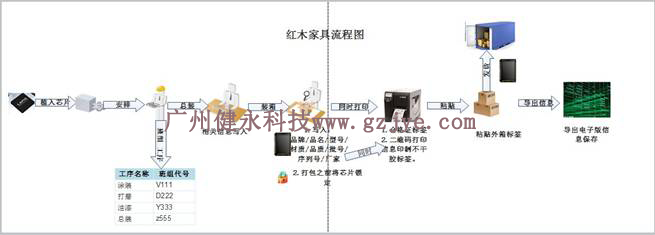
1. Login port:
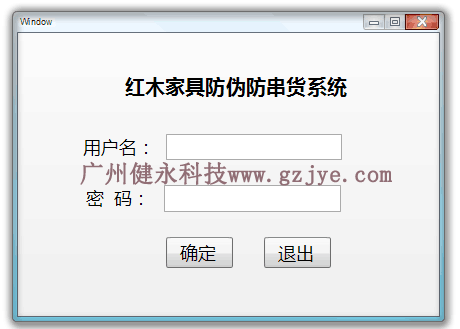
The company arranges operators who are responsible for the input of product inbound data and product outbound data. Only after the person in charge enters the correct user name and password, can they log in to the data entry interface, otherwise they cannot enter the system. This can ensure the accuracy and safety of data entry.
2. The first group of information input:
The chip is implanted when the semi-finished product is assembled, and after the assembly is completed, the finishing process information and the corresponding team information of the assembly are entered through the tablet device. Establish a first set of input information interface, through the team account number and password, you can log in to the input information interface, read the chip ID number, enter the team information and finishing process information, and bind the relevant information with the implanted chip ID number after confirmation.
3. Input of coating information:
After finishing painting, input the corresponding information for polishing and painting. The coating team logs in to the corresponding interface through the account and password, scans the ID number of the implanted chip of the semi-finished product, enters the relevant information of the polishing and painting process, and after confirmation, the coating information is associated with the ID number of the implanted chip.
4. Entry of installation completion information:
After the installation is complete, enter the information corresponding to the general assembly and general inspection. The general assembly inspection team logs in to the corresponding interface through the account and password, scans the ID number of the implanted chip of the finished product, and continues to enter the information corresponding to the general assembly and general inspection. After confirmation, the general assembly inspection information is associated with the implanted chip ID number.
5. Product retrospective entry sheet:
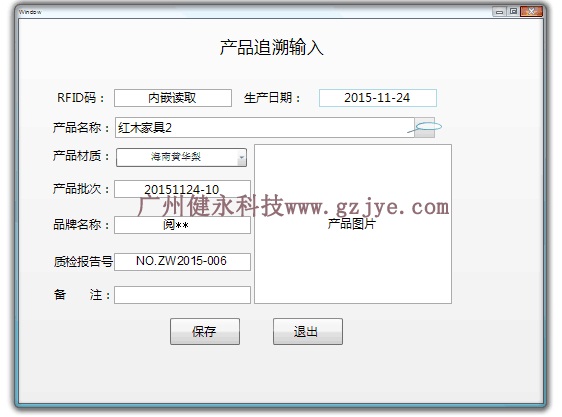
Enter product-related information before packaging, and the embedded content is as follows: brand/product name/model/material/quality/batch number/serial number/manufacturer, etc. The input of product traceability data is the most important part of the traceability of the entire RFID. Only by inputting accurate and effective data can there be data to follow in the later stage. Mainly, the detailed information of each piece of mahogany furniture is encrypted and entered into the high-frequency RFID electronic tag chip with digital technology. The detailed information includes the product quality inspection report number, product material, product name, brand name, manufacturer name, product batch, product Picture, production date and other information.
6. Convert electronic information into QR code information:
The chip must be locked before packaging. The information before locking and the previous information can be exported and saved in electronic version, and the main content can be converted into the certificate label and the QR code printing information to print the self-adhesive label. It needs to be connected to the barcode printer interface, enter the main product information before packaging, and print the corresponding QR code electronic label and certificate label through the printer to capture the main information.
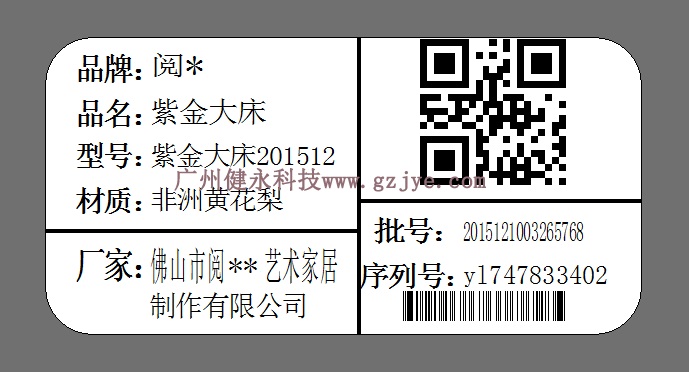
7. Product outgoing traceability form:
Product outbound data entry is by reading the RFID electronic tag built into the mahogany furniture, automatically exporting the corresponding information of the product, and then entering the dealer’s information, so as to track down the problem of the goods, and there is evidence to follow.
8. Mobile phone NFC query:
The query function is a certificate used by market managers, distributors, and consumers to verify the authenticity of products and whether they are collateralized goods. The use of high-frequency RFID technology is mainly due to the uniqueness of the UID code of the RFID electronic tag, and it cannot be copied. As long as the electronic tag exported from the factory is unique, other manufacturers cannot copy the unique code of the electronic tag. Then market managers, distributors, and sellers collect the UID of the electronic tag through the equipment, and whether they are consistent on our software system, they can fully understand the authenticity of this product and whether it is a stray product.
The software system is designed to scan the built-in RFID electronic tag of the product with the NFC function of the mobile phone. If the finished product is genuine, it will automatically enter the background data of our software system, and then pop up the product’s RFID electronic tag UID number, production date, product name, product With information such as material, product batch, brand name, quality inspection report number, distributor, product picture, and number of inquiries, distributors and consumers can understand this product at a glance, which will naturally increase their trust in the product and the manufacturer’s trust. If the UID of the product is inconsistent, the product is a fake or cannot enter the system background.
Four, hardware equipment introduction
1. High-frequency industrial flat panel
It is mainly used in the entry of product inbound data and the entry of product outbound data.
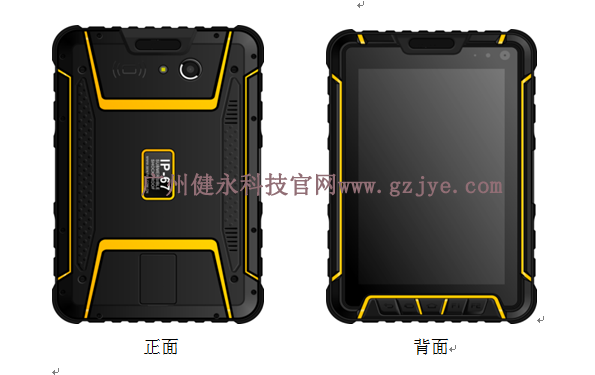
(1) Product overview
JY-H7800 is a new generation of mobile Internet of Things industrial tablet, using the current Android4.1 embedded operating system, integrating a variety of business functions. It adopts a 7-inch LCD display that can be seen under strong light, a battery capacity of more than 7000mAh, an 8-megapixel rear camera with autofocus, and supports a 200W pixel front camera, and supports a maximum of 32G TF external storage. It is a technologically advanced, A powerful and reliable IoT information terminal.
It meets the IP67 protection level, and has passed the 1.2-meter drop test, which can meet the user’s various outdoor mobile operation requirements.
The JY-H7800 industrial panel adopts the design concept of combining platform and modular back clips. It has both an intelligent operating platform and a functional modular back clip that can be flexibly configured, which can meet the different customization wishes of customers.
(2) Product features
◆ Android android 4.1 operating system
◆ IP67 three-proof rating
◆ LCD 7.0 inches, 1280×800 IPS screen, capacitive touch screen, support gravity sensor, compass
◆ Multifunctional data collection is equipped with 1D/2D barcode scanning, RFID reader and fingerprint recognition.
◆ 3G communication, support WCDMA/HSDPA/HSUPA 850/1900/2100MHz
GSM/GPRS/EDGE 850/900/1800/1900MH ◆ Large battery life, using 3.7V 7000mAh or higher polymer battery
◆ Support professional GPS and Beidou positioning
◆ Compatible design with broadband communication and wireless communication
(3) Industry application scenarios
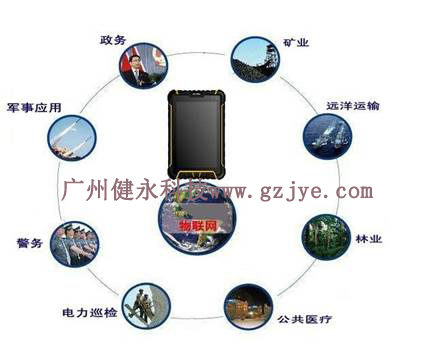
With the continuous development of the Internet of Things, the application of Android handheld terminals has also been widely used. Now it has been widely used in inspections, gas, water, logistics, medical, government, police, electricity, communications, forestry, traceability and other industries .
[ad_2]




